 |
View as a two-column galley proof
View as a feature
The Real Bonnie and Clyde
by Jay Robert Nash
Clyde Barrow (1909-1934) and his petite gun moll mistress Bonnie Parker (1910-1934) were nothing like the characters portrayed in the mythical 1967 film Bonnie and Clyde. They were illiterate, unfeeling killers with vicious, cunning personalities, and, at all times, expressed the nature of poisonous snakes. These two, joined by equally brutal Buck Barrow (Clyde's brother), Ray Hamilton, and other southwestern bandits of the early 1930s, spread terror through Texas, Oklahoma, Kansas, Missouri, and other states, stealing penny ante amounts and earning a reputation as lethal killers. For a period of about two years, 1932-1934, the Barrow gang, never numbering more than five or six members, became the terror of the Southwest.
 |
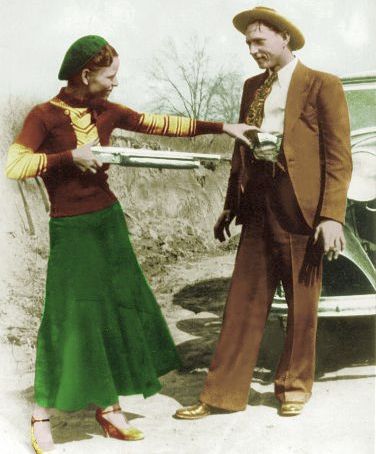 |
| Bonnie gets the drop on Clyde in this snapshot of the two lethal bandits clowning; this and many other photos were left in an apartment the gang abandoned in Joplin, Missouri, on April 13, 1933, where they killed two officers when escaping police. |
The gang preyed upon small store owners, filling stations, and travelers driving along remote roads. They lived in the country for the most part, renting small, cheap cabins, often sleeping in the cars they stole. They were vagrant thieves with high-powered weapons. Contrary to popular belief, they were never cult heroes to the hill people and squalid farmers, who made up their heritage. Bonnie and Clyde preyed upon these poor tenant farmers as much as they attacked and robbed local middle-class shopkeepers.
 |
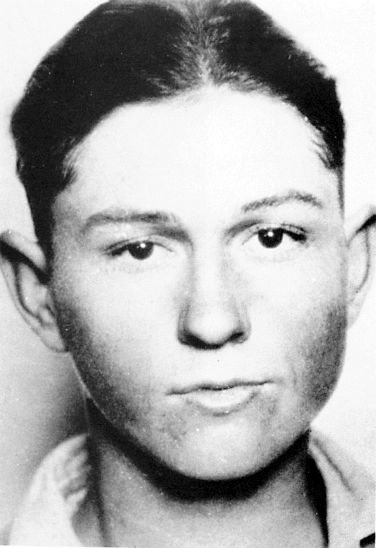 |
| As a teenager, Clyde Barrow had already committed several thefts and was a habitual criminal. |
Reckless and with an utter disregard for the law, they reveled in predicting their own violent ends. The Barrows were fanatically suicidal. To commemorate their death wish, Clyde and Bonnie recorded their almost every movement together, taking photographs of each other in menacing poses, writing long letters to their families in which they portrayed themselves as persecuted, misunderstood, young people and sending even longer missives (and even Bonnie's mawkish poems) to the newspapers. These letters glorified their robberies and attempted to exonerate their killings. Bonnie mooned over the image of being hunted like an animal and she profiled the vicious Clyde Barrow in her awkward poetry as a heroic outsider, who had been driven to crime, who had been forced to commit horrible murders and robberies. It was all an act for the press.
 |
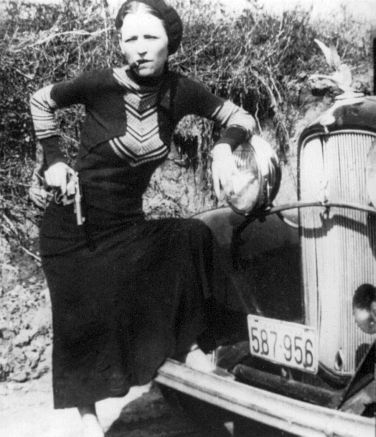 |
| Bandit and killer, Bonnie Parker, posing with gun on hip and cigar in mouth, looking as tough as she really was, although she did not smoke cigars. |
Clyde was an expert killer, who practiced his marksmanship every day, firing all manner of weapons: submachine guns, shotguns, rifles, automatics, and revolvers. He taught Bonnie to fire all these weapons, too, and she, in turn, devised a special trick pocket for Clyde, one where his right trouser was zippered so that he could carry a sawed-off shotgun next to his leg and then, employing the break-away zipper, whip the gun out and fire in one motion. This gun-loving pair appeared in 1932 in the Joplin, Missouri, home of Herbert Farmer, who provided weapons for the bank robbers of that day, asking to look at new Browning Automatic Rifles (BARs) which Farmer had recently stolen from a U.S. Army arsenal.
 |
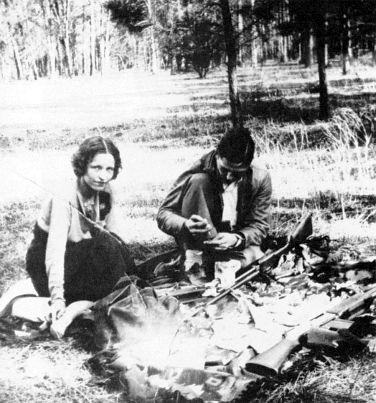 |
| Bonnie and Clyde at a picnic area outside of Dexter, Iowa, on the morning of July 24, 1933 (Clyde is cleaning one of the many weapons in his arsenal); only minutes after this photo was taken, a huge posse attacked the Barrow gang, wounding both Bonnie and Clyde, who escaped. |
Present at the time was James Henry "Blackie" Audett, who watched as Bonnie and Clyde clutched the new BARs Farmer handed them. "They sat there with gleaming eyes," Audett later told this columnist, "stroking and fondling those big guns like they were holding their own children. Spittle dripped from the side of Clyde's mouth and Bonnie was purring like a cat in heat. They were nuts, these two punks, real bad killers. Herb [Farmer] knew it, I knew it, and everybody in the business knew it."
 |
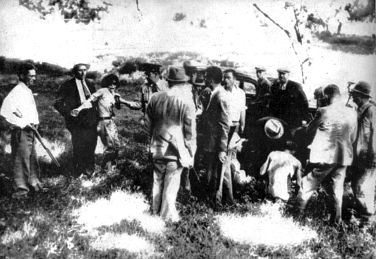 |
| In this startling photo, taken only minutes after a posse attacked the Barrow gang outside Dexter, Iowa on July 24, 1933, Blanch Barrow (wearing sun glasses at left) is restrained and screaming for life of her fatally shot husband, Marvin "Buck" Barrow, Clyde's older brother, who is shown kneeling in his underwear at right, dying from several wounds; Bonnie and Clyde had escaped the area only minutes earlier. |
"When I told Herb to get rid of them by quickly selling them the guns, he said: 'Sell them? Hell, if I don't give them those guns for free, they'll kill me and they'll kill you, too!' Herb gave them the guns for nothing, and when they complained that their stolen car was out of gas, we both gave them money to buy more, just to get rid of them."
 |
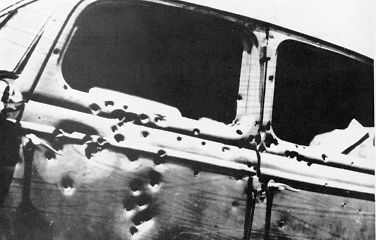 |
| The car in which Bonnie and Clyde were riding when they were ambushed by a posse of Texas Rangers, who riddled the auto as it drove down a dirt road outside Gibsland, Louisiana on May 23, 1934; the murderous bandits were shot to pieces. |
It was not their robberies that brought Bonnie and Clyde to the widespread attention of law enforcement officers. It was their murders. They killed at whim. "They liked killing people," said gang member W. D. Jones after his capture. "It was a game between the two of them, to see who could keep the top score." Clyde killed a sheriff and his deputy at a barn dance at Atoka, Oklahoma on the night of August 5, 1932 (he intended to rob the ticket taker). In December of that year, Clyde killed Doyle Johnson in Temple, Texas, when Johnson protested at Clyde's stealing his car. A short time later, Bonnie laughed when she shot and killed a police officer in Oklahoma after he gave her some directions. On January 6, 1933, Clyde shot and killed police deputy Malcolm Davis, firing his sawed-off shotgun at point blank range. Bonnie congratulated him, saying: "Why, honey, you never miss, do you? You cut that lawman clean in half with one barrel!"
 |
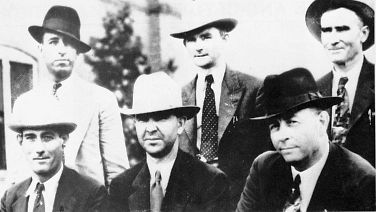 |
| The six Texas Rangers who shot and killed Bonnie and Clyde: (top row, left to right) Ted Hinton, P. Moakley, B. M. Gault (bottom row, left to right), Bob Alcorn, Henderson Jordan, and their leader, Frank Hamer; they had no regrets. |
Bonnie thrilled to the murders Clyde committed and emulated them, but the couple had little or no sexual relationship. Clyde was almost indifferent to heterosexual unions. He preferred young men, admitting to Bonnie that he had become addicted to homosexual practices while in the reformatory. When they took young men into the gang, such as W.D. Jones and Henry Methvin, it was understood that both Bonnie and Clyde would have relationships with these apprentice bandits.
 |
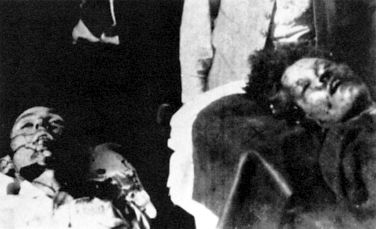 |
| Clyde Barrow and Bonnie Park lying dead in a morgue only an hour after they were slain by a posse of Texas Rangers, their bodies pierced by dozens of submachine gun and Browning Automatic Rifle bullets. |
These killers murdered at least a dozen persons in their two-year crime spree, until they were ambushed by lawmen outside of Gibsland, Louisiana, on May 23, 1934, identified by Ivan Methvin, Henry's father. Both were shot as they drove along a country road. Clyde was driving in his socks and Bonnie was eating a sandwich when the lawmen opened up from the cover of some heavy woods, riddling their car and their bodies with scores of bullets.
Ray Hamilton, one of their gang members, said before going to the electric chair for murder: "Bonnie and Clyde? They loved to kill people, see blood run. That's how they got their kicks. They were dirty people. Her breath was awful and Clyde never took a bath. They smelled bad all the time. They'd steal the pennies off a dead man's eyes." Said one of the Texas Rangers at the ambush, "They were the worst killers in the Southwest. We weren't about to take any chances with those two. Others did and they died. A lot of folks can rest easy now...even Bonnie and Clyde."
View as a two-column galley proof
View as a feature
|
 |